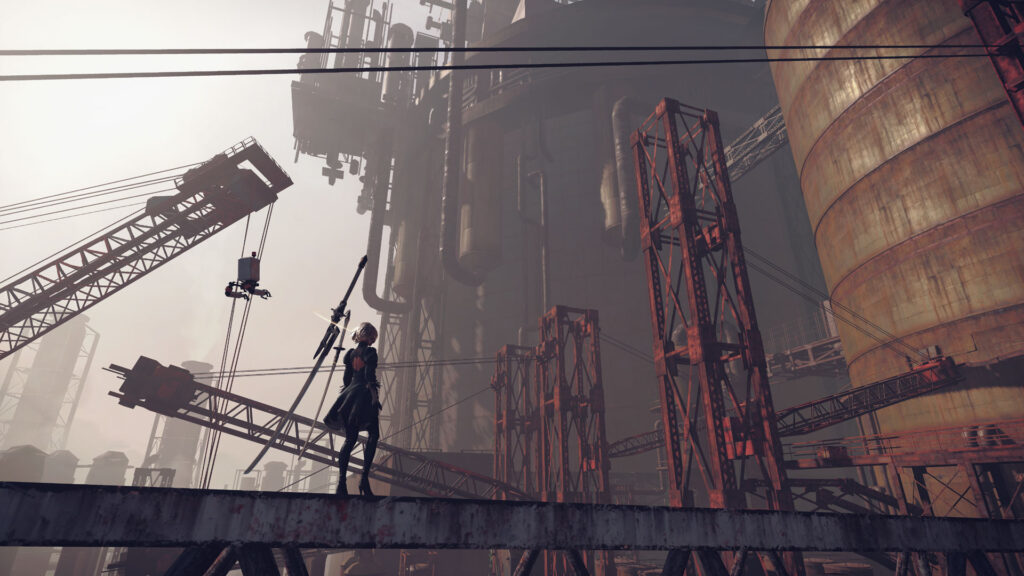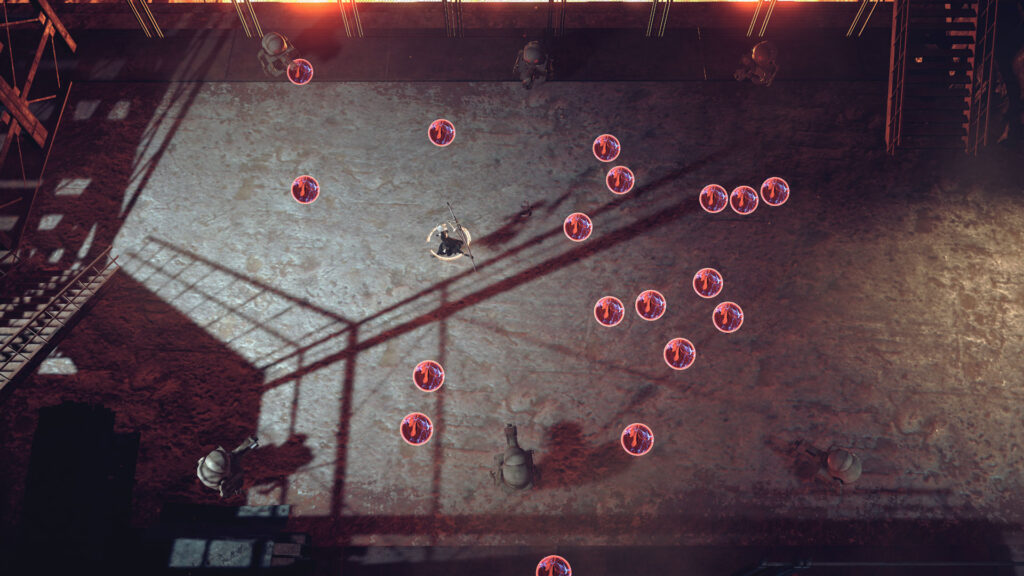Taro Yoko, beloved game director to a passionate fanbase, has not had the same reception from critics and general audiences. While his games have been praised for strong narratives, they’ve always suffered from lackluster gameplay and in NieR’s case, lackluster sales. When people first heard that NieR: Automata would be developed by Platinum Games, fans of both his work and of Platinum Games were excited at the prospect of an honest-to-god great Taro game. It’s been years in the making, but Taro Yoko finally got the game that both he and his fans deserve.
NieR: Automata
Publisher: Square Enix
Developer: Platinum Games, Square Enix
Platform: PlayStation 4
Release Date: March 7th, 2017
Players: 1
Price: $59.99 (Review Copy Received)
This is a review coupled with a supplemental video review. You can watch the video review above, or read the full review of the game below.
Visually speaking, NieR: Automata is a mixed bag. The open world that it showcases is not terribly impressive from a visual standpoint. While they do look pretty in certain instances, they aren’t particularly interesting to look at, especially the main city center. Even though there are a variety of locales, only a couple of them were interesting to gaze upon.
This is large in part to do with the camera work involved in some of these locations. The Bunker is hands down the stand out location of the game, mostly due to its monochromatic color scheme, as well as its lateral camera movement giving it a distinct identity. It makes up for this with its great camera work, which gives certain locations more flair to them and makes playing through these areas way more memorable.
What the game lacks in environmental design it makes up for in character designs. The main protagonist, YoRHa No.2 Type B (2B for short), is hands down the best designed character of the cast and arguably one of the best designed characters this year so far. The gothic-Lolita design, while not necessarily logical in these circumstances, is definitely striking and memorable while giving unique flair to an already very unique game.

While the game does run at 60FPS on the PlayStation 4, there are several moments where the game drops performance to around 40FPS and stays there for a bit. This is mostly noticeable in certain areas, specifically the forest region where you’ll notice it the most. Sadly this also affects combat, which while far from being unplayable does somewhat damper the experience. Most of the time though, the game will play consistently at 60FPS.
If there’s an action RPG that has more fluid combat then NieR: Automata, then I’ve simply not played it yet. This game has the slickest combat that I’ve had the joy of playing in any action RPG. While not as deep as other Platinum titles, there is still depth to be had with this combat system, and more experienced players will have a fun time dissecting its more subtle nuances.
You’re given two weapons to equip at a time with four varieties of weapons at your disposal: short swords, long swords, spears and bracers. Depending on what weapons you have equipped in your light and heavy attack slots, these will determine what kind of combos you can pull off, as well as slightly change their properties. This makes weapon experimentation tons of fun, and you’ll most definitely work towards a preferred weapon combination.
You’re also given a Pod, which acts in the same manner Grimoire Weiss did in the original NieR. You have your basic projectile attack and a variety of special attacks, from a long ranged laser to a giant hammer. The one difference is that if you’re skilled enough, some of these special attacks can actually be used to extend combos, which adds even more depth to a seemingly simple system.
Finally, combat is held together through a dodging system which, when timing it correctly, will allow you to unleash a counter attack. Timing dodges correctly feels incredibly rewarding, and you’ll be using it constantly, as fights can get pretty hectic.
It wouldn’t be a Taro Yoko game, however, if we didn’t have some genre mashing. NieR: Automata has many elements borrowed from shmups, from the various projectile enemies and their bullet patterns to straight up bullet hell sections in the game. The former adds a bit more challenge to combat, while the latter lacks the depth and challenge to make it truly engaging to play through. They do mix the game up however just enough to keep you interested, and they aren’t used to the point where you’ll become tired of playing through them.

There is also a hacking mini game that you get later in the game, and while it makes sense in the context of the narrative, it makes combat way too easy at times, as it’ll almost always be used against tougher opponents seeing as it is the best way to deal damage fast. It also makes higher level side quests almost trivial in how easy they become with said hacking mini game. The mechanic works way better in purpose to the story rather than the gameplay.
NieR: Automata has an interesting upgrade system in the form of chips. These chips come in three forms: Attack, Defense and Support. These can be equipped to your OS in order to upgrade things like damage, defense, evasion, and many other properties. What makes it interesting is that you have a finite amount of room to equip these chips, and the stronger the chip, the more room it takes. You can upgrade chips to take up less room, but you will have to manage what you want by prioritizing.
There are also three OS sets that you can switch between, so you can customize each set differently and switch between them whenever you see fit. You can also upgrade your weapons via items found in the overworld and through the enemies you defeat. The upgrades themselves aren’t very interesting, with your basic damage increase and some pretty vague buffs, but every time you upgrade you reveal a part of a story that is attached to the weapon, making upgrading weapons provide a small narrative payoff.
The best way to get said items for your weapons is through the games 60 side quests. Gameplay-wise they aren’t very interesting, often times requiring you to collect X amount of items or escorting a VIP somewhere. What in lacks in varied gameplay it makes up for in the stories that each side quest tells.
Some of these side quests go into some very dark places, and since everyone in the game is an android, it can tackle a bunch of different subjects you don’t often see in video games. There are some more laid back and comedic side quests, and even they deal with some very interesting concepts, to the point that some of these quests can be pretty messed up in their own right.
In a year that already has a ton of great soundtracks, NieR: Automata might just have the best one to come out all year. I can’t think of a soundtrack that has so many bone chilling songs, with not a single dud among them. The made up language that’s used for most of their vocal tracks is absolutely gorgeous, with one playing in every unique zone. It’s honestly hard to pick a favorite track, but if you were to twist my arm, I’d probably go with the Machine Village theme with its very distinct choir of children.
The English dub is quite solid throughout, with it actually improving as the story goes. 9S’ performance is the stand out of the bunch, mostly due to the material the character himself is given, as well as the transformation he goes through during the main story. If the English dub isn’t your cup of tea, then the option to listen to the Japanese dub is at your disposal right from the start. You can even turn off voice acting altogether if you can’t be bothered to listen to it.
Discussing the story to NieR: Automata is somewhat tricky, not that it’s tough to understand, but more so a lot of what makes it good is hidden behind spoilers. I will say this much about it – NieR: Automata, more so than any other game Taro Yoko has directed, works as much as it does as story due to the nature it uses. This story will never work in any other medium, and that’s one of the reasons it’s so great.
There’s a permeating discussion regarding how narratives in video games should be approached, and NieR: Automata understands the medium that it’s in and uses it to its full advantage. Even certain gameplay elements are tied to the story, and it makes sense narrative-wise as to why they’re designed that way. The ending to the game is the most compelling argument you can make as to why this story could only work in video game format.
Some of you may be wondering if this game could be played without prior knowledge to NieR, and the answer to that is a little complicated. In theory you could play this game without knowing the plot to the original NieR, since it does a good job at explaining its premise, but several moments in this game won’t have the same impact it would on someone who is familiar with the first game. There’s also a lot of supplementary material that was written outside of the games detailing more of the backstory of Automata, but in my playthrough there was only one instance where that information came into play.
The game boasts a whopping 26 endings, but luckily only five of them are important, while the rest act as joke endings. It may sound daunting at first trying to get all five endings, but in reality it’s practically a necessity if you want the full story. Getting one ending might seem like a proper place to finish at first glance, but the game kindly encourages you to keep replaying the game and getting its various endings to see the full picture.
Calling them endings isn’t even really accurate, as the first two endings only constitute the first half of the game, with the remaining three making up the second act. Luckily, each new playthrough adds new sidequests and new perspectives to keep them fresh and intriguing. Do yourself a favor and get the main five endings.
NieR: Automata is very much reflective of its creator Taro Yoko. Both are quirky and weird to say the least, but at the same time there’s not really anything else to compare them to, making them one of a kind.
It’s clear that Yoko loves the medium and uses everything that makes video games unique to create something wholly original. Whether or not this is it for the NieR series is yet to be seen, but if it were to end with Automata, then I’d be glad to see if go on such a high note. Despite its minor blemishes, this is a quintessential title to own if you own a PlayStation 4.
NieR: Automata was reviewed on PlayStation 4 using a review copy provided by Square Enix. You can find additional information about Niche Gamer’s review/ethics policy here.
The Verdict: 9
The Good:
- The best goddamn soundtrack this year has to offer
- Fluid and fun combat
- Story, both the main quest and side quests, are fantastic
The Bad:
- Overworld design isn’t super interesting
- Some game mechanics make game a little too easy at times
- Game has some pretty noticeable performance drops




